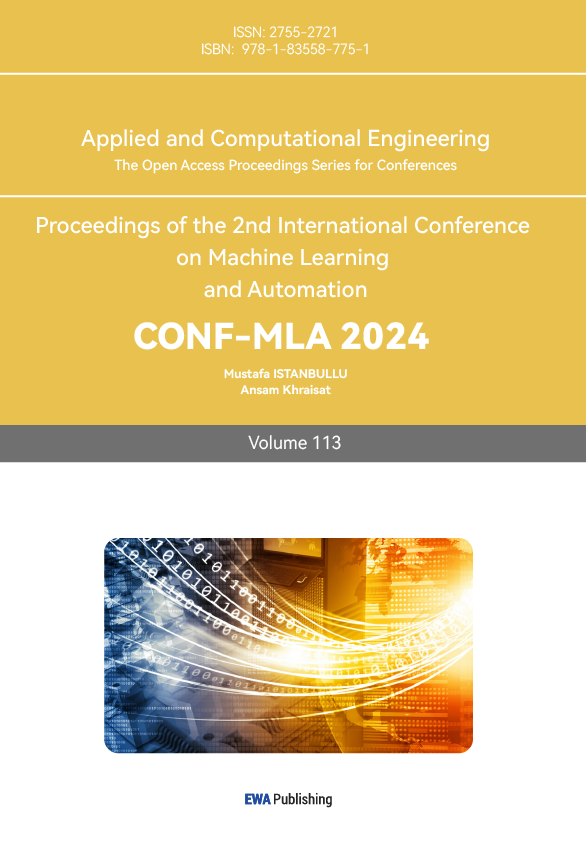References
[1]. E. Benetos, S. Dixon, Z. Duan, and S. Ewert, “Automatic music transcription: An overview,” IEEE Signal Processing Magazine, vol. 36, no. 1, pp. 20–30, 2018.
[2]. B. Bhattarai and J. Lee, “A comprehensive review on music transcription,” Applied Sciences, vol. 13, no. 21, p. 11882, 2023.
[3]. A. Krizhevsky, I. Sutskever, and G. E. Hinton, “Imagenet classification with deep convolutional neural networks,” Advances in neural information processing systems, vol. 25, 2012.
[4]. C. Szegedy, W. Liu, Y. Jia, P. Sermanet, S. Reed, D. Anguelov, D. Erhan, V. Vanhoucke, and A. Rabinovich, “Going deeper with convolutions,” in Proceedings of the IEEE conference on computer vision and pattern recognition, 2015, pp. 1–9.
[5]. K. He, X. Zhang, S. Ren, and J. Sun, “Deep residual learning for image recognition,” in Proceedings of the IEEE conference on computer vision and pattern recognition, 2016, pp. 770–778.
[6]. Y. Yan, F. Cwitkowitz, and Z. Duan, “Skipping the frame-level: Event-based piano transcription with neural semi-crfs,” Advances in Neural Information Processing Systems, vol. 34, pp. 20583–20595, 2021.
[7]. Y. Yan and Z. Duan, “Scoring intervals using non-hierarchical transformer for automatic piano transcription,” arXiv preprint arXiv:2404.09466, 2024.
[8]. C. Hawthorne, E. Elsen, J. Song, A. Roberts, I. Simon, C. Raffel, J. Engel, S. Oore, and D. Eck, “Onsets and frames: Dual-objective piano transcription,” arXiv preprint arXiv:1710.11153, 2017.
[9]. Q. Kong, B. Li, X. Song, Y. Wan, and Y. Wang, “High-resolution piano transcription with pedals by regressing onset and offset times,” IEEE/ACM Transactions on Audio, Speech, and Language Processing, vol. 29, pp. 3707–3717, 2021.
[10]. T. Kwon, D. Jeong, and J. Nam, “Polyphonic piano transcription using autoregressive multi-state note model,” arXiv preprint arXiv:2010.01104, 2020.
[11]. R. Kelz, S. Bock, and G. Widmer, “Deep polyphonic adsr piano note transcription,” in¨ ICASSP 2019-2019 IEEE International Conference on Acoustics, Speech and Signal Processing (ICASSP). IEEE, 2019, pp. 246–250.
[12]. A. Vaswani, “Attention is all you need,” Advances in Neural Information Processing Systems, 2017.
[13]. S. Sarawagi and W. W. Cohen, “Semi-markov conditional random fields for information extraction,” Advances in neural information processing systems, vol. 17, 2004.
Cite this article
Hao,S. (2024). Transformer-based Note level Automatic Drum-Set Transcription. Applied and Computational Engineering,113,52-56.
Data availability
The datasets used and/or analyzed during the current study will be available from the authors upon reasonable request.
Disclaimer/Publisher's Note
The statements, opinions and data contained in all publications are solely those of the individual author(s) and contributor(s) and not of EWA Publishing and/or the editor(s). EWA Publishing and/or the editor(s) disclaim responsibility for any injury to people or property resulting from any ideas, methods, instructions or products referred to in the content.
About volume
Volume title: Proceedings of the 2nd International Conference on Machine Learning and Automation
© 2024 by the author(s). Licensee EWA Publishing, Oxford, UK. This article is an open access article distributed under the terms and
conditions of the Creative Commons Attribution (CC BY) license. Authors who
publish this series agree to the following terms:
1. Authors retain copyright and grant the series right of first publication with the work simultaneously licensed under a Creative Commons
Attribution License that allows others to share the work with an acknowledgment of the work's authorship and initial publication in this
series.
2. Authors are able to enter into separate, additional contractual arrangements for the non-exclusive distribution of the series's published
version of the work (e.g., post it to an institutional repository or publish it in a book), with an acknowledgment of its initial
publication in this series.
3. Authors are permitted and encouraged to post their work online (e.g., in institutional repositories or on their website) prior to and
during the submission process, as it can lead to productive exchanges, as well as earlier and greater citation of published work (See
Open access policy for details).
References
[1]. E. Benetos, S. Dixon, Z. Duan, and S. Ewert, “Automatic music transcription: An overview,” IEEE Signal Processing Magazine, vol. 36, no. 1, pp. 20–30, 2018.
[2]. B. Bhattarai and J. Lee, “A comprehensive review on music transcription,” Applied Sciences, vol. 13, no. 21, p. 11882, 2023.
[3]. A. Krizhevsky, I. Sutskever, and G. E. Hinton, “Imagenet classification with deep convolutional neural networks,” Advances in neural information processing systems, vol. 25, 2012.
[4]. C. Szegedy, W. Liu, Y. Jia, P. Sermanet, S. Reed, D. Anguelov, D. Erhan, V. Vanhoucke, and A. Rabinovich, “Going deeper with convolutions,” in Proceedings of the IEEE conference on computer vision and pattern recognition, 2015, pp. 1–9.
[5]. K. He, X. Zhang, S. Ren, and J. Sun, “Deep residual learning for image recognition,” in Proceedings of the IEEE conference on computer vision and pattern recognition, 2016, pp. 770–778.
[6]. Y. Yan, F. Cwitkowitz, and Z. Duan, “Skipping the frame-level: Event-based piano transcription with neural semi-crfs,” Advances in Neural Information Processing Systems, vol. 34, pp. 20583–20595, 2021.
[7]. Y. Yan and Z. Duan, “Scoring intervals using non-hierarchical transformer for automatic piano transcription,” arXiv preprint arXiv:2404.09466, 2024.
[8]. C. Hawthorne, E. Elsen, J. Song, A. Roberts, I. Simon, C. Raffel, J. Engel, S. Oore, and D. Eck, “Onsets and frames: Dual-objective piano transcription,” arXiv preprint arXiv:1710.11153, 2017.
[9]. Q. Kong, B. Li, X. Song, Y. Wan, and Y. Wang, “High-resolution piano transcription with pedals by regressing onset and offset times,” IEEE/ACM Transactions on Audio, Speech, and Language Processing, vol. 29, pp. 3707–3717, 2021.
[10]. T. Kwon, D. Jeong, and J. Nam, “Polyphonic piano transcription using autoregressive multi-state note model,” arXiv preprint arXiv:2010.01104, 2020.
[11]. R. Kelz, S. Bock, and G. Widmer, “Deep polyphonic adsr piano note transcription,” in¨ ICASSP 2019-2019 IEEE International Conference on Acoustics, Speech and Signal Processing (ICASSP). IEEE, 2019, pp. 246–250.
[12]. A. Vaswani, “Attention is all you need,” Advances in Neural Information Processing Systems, 2017.
[13]. S. Sarawagi and W. W. Cohen, “Semi-markov conditional random fields for information extraction,” Advances in neural information processing systems, vol. 17, 2004.









